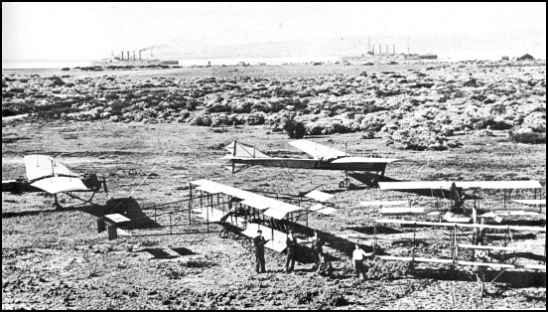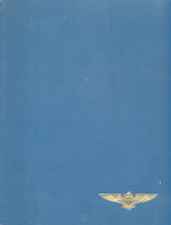
AVIATOR |
 |
|
"Harkness Antoinnette monoplanes and biplanes of Curtiss and Walsh moored in the sand in this 1911 view looking north across "North Coronado Island" (Historical Collection, Title Insurance and Trust Company) from Jackrabbits to Jets |
|
|
|
by A. R. Parkhurst, Jr., Daily Journal and Tribune, Knoxville, Tennessee: July 10, 1910, Transcribed by Bob Davis - 9-25-03 "Anthony C. Drexel, son of the millionaire banker, is another to take up the sport and he has made several successful trips aloft. He, too, will join in some of the many races in the air in the near future." In tracing various events of the aviators of the world in the past year or so it might well to begin with Bleriot and his English Channel flight. This up to that time - July 25, 1909 - was by all odds the most spectacular. This feat was duplicated by Jacques de Lesseps, a grandson of Count Ferdinand de Lesseps, builder of the Suez Canal. De Lesseps, however, came to grief and several times he fell into the channel and but for the assistance of boatmen he would not be living today to boast of his performance." and "Those who have signified their intention of entering the endurance flights are Captain Rolls and Count Jacques de Lesseps. Both are now in Montreal, having crossed the ocean to compete in flights on this side of the Atlantic. Hamilton, M. J. Seymour and Capt.Thomas S. Baldwin, Clifford B. Harmon, Harry S. Harkness and Glenn Curtiss will also be among the flyers at this meet." Bob Davis |
|
Knoxville Daily Journal and Tribune, Knoxville, Tennessee: September 16, 1910. Transcribed by Bob Davis - 3-18-07 |
|
HARRY HARKNESS FINANCES CHARLIE WALSH |
|
CHARLIE FAILS FLYING TESTS In the meantime the Macomber engine was returned and Walsh proceeded to make acceptance flights before John Kiley, who represented the Harkness in Los Angeles. It was accepted and shipped to North Island in the latter part of April 1911. For goodwill and publicity purposes, Harkness turned the plane over to Kiley, little more has been uncovered regarding this plane except that Harkness seemed pleased with it and the Macomber engine. It was flown quite often from the San Diego Aero Club Camp. In later 1912, the Walsh's were in New York and they visited the Mineola Flying Field on Long Island, Alice, always nosing around, spotted a tent with a sign on it "No Trespassing." She couldn't resist peeking inside; her eyes bulged as she screamed for Charlie to have a look. No mistake, it was the Harkness Silver Dart. They could not find out any more about it, however, and never heard of it, or saw it again. |
|
|
|
"On February 7, Harry Harkness made history by flying twenty-one miles to the Mexican border." On the same page you will find 37! other photographs, all of which were selected from the article, The Only Safe and Sane Method...The Curtiss School of Aviation , which is found in The Journal of San Diego History, Winter 1979, Volume 25, Number 1. You can access the page by clicking on the title above. |
 |
JACKRABBITS TO JETS The History of North Island San Diego, California by Elretta Sudsbury Product Details Library Binding: 400 pages ; Dimensions (in inches): 1.25 x 11.50 x 8.50 Publisher: San Diego Pub Co; Revised edition (November 1992) ISBN: 0912495103 Out of Print |
Suggested by Donald Heflinger, 7-25-11 I happened across your web site on Harry S Harkness when I tried looking for information about a passage from a book I checked out of our local library: Jackrabbits to jets; the history of North Island, San Diego, California by Elretta Sudsbury 1967 The passage states: In 1911 a war message is delivered to Tijuana by millionaire aviator Harry S Harkness, a captain in the US Aeronautical Reserve, from his French Antoinette monoplane that took off from Curtiss' flying school on North Island with orders to Lt George Ruhlen. This passage is stated in a chapter describing the invasion of northern Mexico as part of the Mexican Revolution started in 1910 when partisans of the Partido Liberal Mexico (PLM), led by Ricardo Flores Magón, captured Mexicali and went on to take over Tecate and Tijuana. The news of the capture of Mexicali by Flores Magon excited California Industrial Workers of the World (IWW) radicals in Los Angeles, and Jack London, the writer, circulated a manifesto proclaiming they were aligned with Flores Magon. It happens that prior to the capture of Mexicali, Jose Aria Leyva and Simon Berthold, directed by Flores Magon, stopped at the Industrial Workers of the World (IWW) headquarters in Holtville in the Imperial Valley and received union worker support for their revolutionary intent to control Mexicali. The people in the United States were hopeful that all of Baja California could be severed from the Mexican government and eventually become part of the US. For me, the participation by millionaire aviator Harry S Harkness in this revolution is a little surprising, for one generally would not expect a millionaire to side with union workers beliefs. When I read the passage about Harry S Harkness, I recognized the last name to be that of the Stephen Vanderburgh Harkness that had been a secret investor in Standard Oil, but Harry was not known to me. On a prior occasion, I had explored the Harkness name on the Internet because there is a street in the North Redondo Beach, CA, in the Villa tract near where I live named after him (all the streets in this tract are named after millionaires known to Henry Huntington, who was the original owner and promoter of the tract). I have learned that Harry S Harkness is the grandson of Stephen Vanderburgh Harkness, whose son, Lamon V Harkness, was Harry's father. Apparently there was a lot of wealth that lasted several generations. Learning about Harry S Harkness from your web site was a real delight. Thanks again, -Don |


|